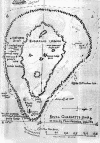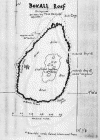|
Diving the South China Sea in 1989 Unknown Wreck on Royal Charlotte Reef It was a fantastic experience to dive the little known corals of the South China seas in Philippine and Malaysian waters, In fact we were diving areas that had never been seen or dived before. I joined, a number of members of’ the British Society of Underwater Photographers in Kota Kinabalu in Sabah, North Borneo. There we boarded a ketch by the name of Four Friends. She was a ferro-cement yacht commissioned and built in New Zealand 15 years ago and skippered by a delightful character Warren Blake who knew these seas well. He was an excellent raconteur, a man of many interests with a wealth of knowlege about East India men wrecked in the South China Sea. He was one of those rare unforgettable personalities whom it is a great privilege to meet in life. His mate was a Sea Dayak, Tudgey who had been brought up on the seas and whose forebears had been pirates. Often he would go off with his spear gun and bring back a bonito for Vanessa, the cook, to prepare for dinner. He was a natural, but not altogether reliable diver. We were away at sea for nearly three weeks during which time we saw few ships and no dry land. We travelled 1000 kilometres, and on the long hauls the sails were unfurled and the ketch was a very fine sight. Fortunately, the weather was hot and sunny and the sea was calm. The occasional shower was delicious. We would rush out to collect rainwater and stand in the rain to rinse the salt from our hair and off our skin. So we set sail to Philippine waters off Palawan. We were bound for the Royal Captain Reef, but on approaching, we saw a fishing boat using explosives. In fact these waters we found were quite devastated and almost devoid of’ fish. Our cautious captain on sighting a boat would send the women down to the cabin and muster the men on deck, for we were in pirate waters. Most of the fishermen were Muslims and did not approve of women in scant attire at sea. We proceeded to North East Investigator Shoal. Mike, Tony and Warren planted a park bench on the shoal for amusement and had their pre-dinner drink. While there, a boat came by and moored and a small dinghy from it rowed over to our yacht. To hide from them we women spent a long time in sweltering heat in the cabin below wondering what was happening on deck. In fact, the fishermen were friendly and knew Warren from a previous meeting when the ketch was moored on Royal Captain Reef. They brought with them their chart as they were not certain where they were having only primitive navigation aids. The previous day they had been fishing at Tennaw Reef and had been fired at and hit by a Vietnamese boat. The six nations around The South China Sea dispute the central area hopefully to gain the oil rights. In fact it would be too dangerous to dive in these parts. We heard from Warren many horrific stories about the Vietnamese boat people. The group dived up to four times a day. For this expedition a computer is a ‘must’. It is remarkable how it changes the whole attitude to diving and facilitates multiple dives. It was quite easy to decompress on the shallow reef for we were diving up to 50 metres in the early part of the dive. My logbook entries remind me of the great variety of’ corals seen. There was every variety of hard coral and more beautiful fan corals of all colours, gorgonians with feather stars at the tip and black coral. The soft corals were even more abundant and there were some huge barrel shaped sponges large enough for a diver to climb into. In the Philippine waters the fish life was sparse due to the explosive fishing, but we did see sea squids of different hues and delightful nudibranchs, but the most memorable event was watching a manta ray display towards the end of one dive. We ascended to 15 metres and caught a glimpse of’ the ray. For half an hour we watched it somersaulting and eventually when we surfaced we found ourselves a great distance away from our boat. We had to be picked up by the dory. From North East Investigator shoal we sailed to Boxall Reef and here we spent two days diving. My logbook refers to a colourful cave with sponges, sea fans and soft corals. There were numerous small coral reef fish. On one dive the reef wall was a blaze of colour with hard and soft corals of varying sizes, shapes and contours. On one dive a manta ray swam between the reef wall and me. We found a small green turtle and took it back to the ketch to release later. We sailed back to the Royal Captain, a reef known well to the skipper as he had spent three months there with a French group of n archaeologists about four years ago. The reef is so named because an East India man was wrecked on it in 1793. The crew took to the longboats and the only casualty was a drunk who refused to leave the ship. All that remains is a gun and an anchor at the depth of 49 metres. Again referring to my logbook I see the same superlatives with reference to the corals and fish seen. Though there was so much to see the reef-faces differed from one aspect of the reef to another and certainly between each reef. I saw my first hammerhead and a few reef sharks during these dives. Following one dive in the lagoon the Captain took us to where the French team had been investigating. These finds are now displayed in the Museum at Manila. The wreck had been a Chinese junk dunk during the reign of Emperor Wan Li in the late 16th or early 17th century. The boat had been carrying to Borneo gongs, beads and what we know as Ming china. I was fortunate to find beads, parts of brass gongs and chards of lung pottery. As we returned by dory to the ketch we saw a modern wreck of a Japanese ship. Noddy terns were nesting on the upturned hull with some hatched chicks far from the coast of Palawan. We left the Philippine waters and returned to Malaysian. We felt safer, but later heard from a relative of one of our party that pirates had intercepted him some two years previously on the East Coast of Borneo. We sailed to Royal Charlotte Reef, named after a sister ship of Royal Captain. We moored off a defunct lighthouse. Mooring was not easy. Warren would scale the foremast and donned his polaroids. The contrast of deep sea and coral reefs was greater when he wore them. Tudgey would man the anchor. Mike who organised the trip was at the wheel and watched the depth sounder. There was much shouting of direction and eventually we would find a safe anchorage. The difficulty was the sudden drop-off. A change of wind direction could blow the ketch against the reef or else the anchor could easily drag. The Royal Charlotte was the high-light of the trip and we were loath to leave. All my records are in the superlative. The fish were in abundance. There were shoals of bonitos, of barracuda of varying sizes, tuna, Royal Charlotte humphead, parrot fish, trigger fish and sweet lips to name but many. I saw no stonefish and just a few scorpion fish. In fact quite a small triggerfish caused the only incident. Emma was bitten through her wet suit by one. At a depth of 30 to 50 metres were the most beautiful coloured fan corals, gorgonians and black corals with feather stars creeping over them. Soft corals were numerous and very various. Again, at depth we saw huge barrel shaped sponges. Those who went first and dived to more than 30 metres were lucky enough to see schools of hammerhead sharks. Mike Wong was in raptures saying there were hundreds of them. Perhaps not as many as that, but at times they were everywhere above, below and beside us ‘people watching’. In the early morning they appeared to be going west and in the evening returning to the east. It was the one occasion when one very curious one came close to me and I froze solid. We spent a few days at this reef, because the diving was so fabulous. We saw shoals of tuna, barracuda, unicorn, bat, trigger, hump head parrot fish and surgeonfish. The night dives were not as colourful as the Red Sea for there were so many soft coral. After the second dive on this reef, Bryan came up say that he had found a wreck. Warren was thrilled and was soon out taking bearings as to its position. I noted he had not marked it on the map. No doubt he hoped to return to explore it at a later date. He was extremely knowledgeable and knew the whereabouts of all the East India Company ships wrecked in the South China Seas from 1600 until 1850. During the next three days parties went out to investigate the wreck. It lay in about 5 metres of water. Much of it was encrusted in coral and the two guns found were impossible to move as they lay embedded in it. A number of seals were found, yet to be identified, but the most exciting find were two lead ingots weighing 80 kilograms and stamped with Wm. Blackett. Warren already had two similar in his hold but with the East India Man Insignia on them. These came from a known a known wreck sunk in1700. There was scope for a lot more research from the archives before further excavations. We left very little time to dive Louisa Shoal. We saw a great many hammerheads and the diving promised to be very good, but we had to return to Miri in Sarawak for our flight home. The holiday was memorable. It was a privilege to dive sites where no one has been before and an exceptional thrill to see the diversity of life in the shallow water and at depth. .*.*.*.*.*.
|


